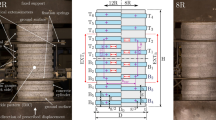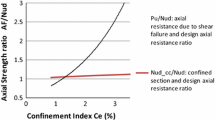Abstract
An experimental program has been made in order to study the confined concrete behavior when its strength changes from traditional values to high strength values and with confinement levels ranging from 0% to values higher than 4%. The specimen shape and size have also been included as variables.
With the data experimentally achieved, the parameters that define the stress-strain curve for concrete were adjusted using a statistical methodology that gives us suitable approximation levels.
A stress-strain curve model is proposed, which lets us know precisely the confined concrete behavior up to high strain levels and analyze the material ductility.
The achieved improvement, thanks to the confinement, was quantified regarding the parameters that define the concrete behavior, particularly the maximum strength, the strain at the peak and the ductility.
Résumé
Un programme expérimental a été développé pour étudier le comportement du béton confiné avec une teneur en armature transversale de 0% à 4%. L'étude analyse des bétons de résistance entre 25 MPa et 100 MPa. D'autres variables ont été la forme et la dimension des éprouvettes.
Avec les résultats expérimentaux obtenus on a réalisé une analyse statistique pour définir les paramètres de la courbe Contrainte-déformation avec une bonne corrélation.
On a proposé un modèle de courbe Contrainte-déformation qui montre le comportement du béton à hautes performances confiné jusqu'à des niveaux de déformation très élevés, et qui permet l'analyse de la ductilité du matériau.
Les performances obtenues grâce au confinement ont été quantifiées d'après les paramètres qui définissent le comportement du béton, en particulier de sa résistance, de la déformation au pic et sa ductilité.
Similar content being viewed by others
Refernces
‘Code espagnol du béton structurel E.H.E.’, (Madrid, 1999) (in Spanish).
‘Règlement Argentin pour Constructions Civiles ‘CIRSOC 201’, (Buenos Aires, 1982) (in Spanish).
‘Commentary on building code requirements for reinforced concrete (ACI 318-95)’, ACI Committee, American Concrete Institute, (Detroit, 1995).
‘Code Modèle CEB—FIP 1990 pour béton structurel’, G.E.H.O. C.E.B. (Madrid, 1995) (in Spanish).
‘High performance concrete. Recommended extensions to the Model Code 90 Research needs’,Bulletin d'Information CEB no228 (1995).
Serna Ros, P., Yazzar, S. et Coca, A., ‘Influence de la granulométrie des granulats dans les caractéristiques des bétons à haute résistance’,Hormigón y Acero 213 (Séville, 1999) (in Spanish).
Serna Ros, P., Yazzar, S. et Coca, A., ‘Influence du confinement sur la ductilité du béton à haute résistance’, 1er Congrès de l'Association Scientifique Technique du Béton Structurel ACHE (Séville, 1999) (in Spanish).
Yazzar, S., ‘Étude de la ductilité d'éléments comprimés fabriqués avec béton à haute résistance soumis à charges cycliques de flexion’,Thèse doctorale, Université Polytechnique de Valence (Valencia, 2000) (in Spanish).
Recueil des normes UNE, ‘Essais pour bétons, mortiers et ses composants’, Tome no5. Série 83 (in Spanish).
Toralles, B., Agulló, L. et Gettu, R., ‘Procès pour l'optimisation des bétons à haute résistance’,Hormigón y Acero 2 (1998) 19–30 (in Spanish).
Alaejos Gutierrez, P. and Fernández Cánovas, M., ‘Caractérisation mécanique d'un béton à haute résistance’,Hormigón y Acero 191 (1994) (in Spanish).
Ahmad, S.H. and Mallare, M.P., ‘A comparative study of models for confinement of concrete by circular spirals’,Magazine of Concrete Research 46 (166) (1994) 484–490.
Ahmad, S.H. and Shah, S.P., ‘Stress-strain curves of concrete confined by spiral reinforcement’,ACI journal 79 (6) (1982) 484–490.
Balmer, C.G., ‘Shearing strength of concrete under high triaxial stress-computation of Moorhr's envelope as a curve’,Structural research report SP-23 (Denver, Colorado, 1949).
Bjerkeli, L., ‘Deformation properties and ductility of high strength concrete’, in ‘Utilization of HSC Symposium’, SP—121 (ACI, Detroit, 1990) 215–238.
Considére, A., ‘Experimental Researches on Reinforced Concrete’ (McGraw Publishing Co., 1899).
Cusson, D. and Paultre, P., ‘High Strength concrete columns confined by rectangular ties’,Journal of Structural Engineering ASCe 120 (3) (1994) 783–804.
Cusson, D. and Paultre, P., ‘Stress-strain model for confined High-Strength concrete’,Journal of Structural Engineering, ASCE 121 (3) (1995) 468–477.
Cusson, D., de Larrard, F., Boulay, C. and Paultre, P., ‘Strain localization in confined high strength concrete columns’,Journal of Structural Engineering, ASCE 122 (9) (1996) 1055–1061.
Chin, M.S., Mansur, M.A. and Wee, T.H., ‘Effects of shape size and casting direction of specimens on stress-strain curves of high strength concrete,’ACI Materials Journal 94 (3) (1997) 209–219.
Diniz, S.M.C. and Franggopol, D.M., ‘Strength and ductility simulation of high-strength concrete columns’,Journal of Structural Engineering, ASCE,123 (10) (1997) 1365–1374.
El-Dash, K.M. and Ahmad, S.H., ‘A model for stress-strain relationship of rectangular confined normal and high-strength concrete columns’,Mater. Struct. 27 (1994) 572–579.
El-Dash, K.M. and Ahmad, S.H., ‘A model for stress-strain relationship of spirally confined normal and high-strength concrete columns’,Magazine of Concrete Research 47 (171) (1995) 177–184.
Fafitis, A. and Shah, S.P., ‘Predictions of ultimate behavior of confined columns subjected to large deformations’,A.C.I. Journal 82 (4) (1985) 423–433.
Hognestad, E.; ‘Concrete stress distribution in ultimate stress design’,A.C.I. Journal 52 (3) (1995) 455–480.
Kent, D.C. and Park, R., ‘Flexural members with confined concrete’,Journal of Structural Division, ASCE 27 (7) (1971) 1969–1990.
Mander, J.B., Priestley, M.J.N. and Park, R., ‘Observed stress-strain model for confined concrete’,Journal of structural Engineering, ASCE 114 (8) (1988) 1827–1849.
Mander, J.B., Priestley, M.J.N. and Park, R., ‘Theoretical stress-strain model for confined concrete’,Journal of Structural Engineering, ASCE 114 (8) (1988) 1804–1826.
Nagashima, T., Sugano, S., Kimura, H. and Ichikawa, A, ‘Monotonic axial compression test on ultra high strength concrete tied columns’, Proceedings of 10th World Conference of Earthquake Engineering (Madrid, 1992) 2983–2988.
Polat, M.B., ‘Behavior of normal and high strength concrete under axial compression’, M.A.Sc. Thesis, Department of Civil Engineering (University of Toronto, 1992) 175.
Razvi, S.R. and Saatcioglu, M., ‘Strength and deformability of confined high strength concrete columns’,ACI Structural Journal 91 (6) (1994) 678–687.
Roy, H.E. and Sozen, M.A., ‘Ductility of concrete’,Flexural mechanics of reinforced concrete, A.C.I., SP-12, (1964) 213–224.
Saatcioglu, M. and Razvi, S.R., ‘Strength and ductility of confined concrete’,Journal of Structural Engineering, ASCE 118 (6) (1992) 1590–1607.
Sargin, M., ‘Stress-strain relationships for concrete and the analysis of structural concrete sections’, Solid Mechanics Division, University of Waterloo, Study 4 (1971) 177.
Scott, B.D., Park, R. and Priestly, M.J.N., ‘Stress-strain behavior of concrete confined by overlapping hoops at low and high strain rates’,ACI Journal,79 (1) (1982) 13–27.
Sheikh, S.A., ‘A comparative study of confinement models’,ACI Journal 79 (4) (1982) 296–306.
Sheikh, S.A. and Toklucu, M.T., ‘Reinforced concrete columns confined by circular spirals and hoops’,ACI Structural Journal 90 (5) (1993) 542–553.
Sheikh, S.A. and Uzumeri, S.M., ‘Analytical model for concrete confinement in tied columns’,Journal of Structural Division, ASCE 108 (12) (1982) 2703–2722.
Soliman, M.T. and Yu, C.W., ‘The flexural strain relationship of concrete confined by rectangular transverse reinforcement’,Magazine of Concrete Research 19 (61) (1967) 223–238.
Vallenas, J., Bertero, B. and Popov, E., ‘Concrete confined by rectangular hoops and subjected to axial loads’,Journal of Structural Engineering Report No UCB/EERC—77/13, Earthquake Engineering Research Center, Berkeley (1977) 114
‘Intégration de contraintes dans des sections de béton soumises à flexo-compression déviée’,Revue Méthodes Numériques pour Calcul et Dessin et Génie (Revista Métodos Numéricos para Cálculo y Diseño en ingeniería) (1999) (in Spanish).
Author information
Authors and Affiliations
Rights and permissions
About this article
Cite this article
Serna Ros, P., Yazzar, S.A. & Coca Calvo, A. Influence of confinement on high strength concrete behavior. Mat. Struct. 36, 439–447 (2003). https://doi.org/10.1007/BF02481523
Received:
Accepted:
Published:
Issue Date:
DOI: https://doi.org/10.1007/BF02481523




